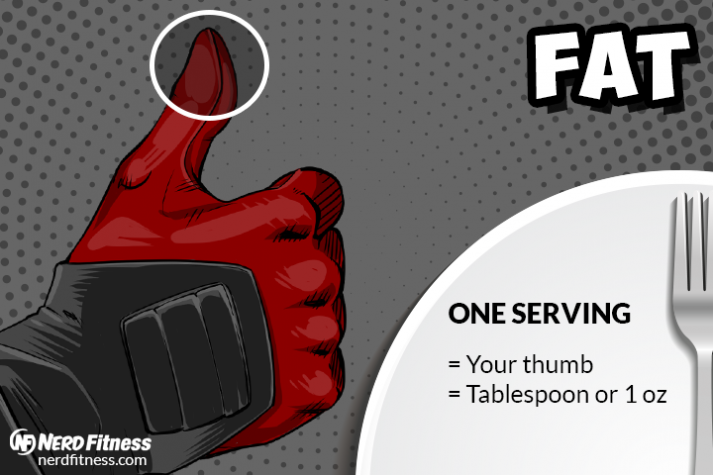
So you want to start eating healthy, eh?
We’ve helped hundreds of thousands of people like you transform into actual superheroes, and we focus on proper nutrition to do so.
The Truth About Healthy Eating

It’s really easy to tell people the following advice:
“To lose weight, just eat more REAL food.”
“Just eat less fast food and junk food.”
“Try to eat more organic vegetables watered by unicorn tears, farm-to-table meals served by centaurs, and kale omletes made with eggs from chickens that you raised since birth.”
Okay so maybe people don’t say the last one.
But it’s not far from what healthy people say to people who can’t seem to get healthy.
In my opinion, these positions are completely out of touch with reality and it makes me plum dog mad.
For starters, fast food is crazy delicious and dirt cheap, and often the only way that many busy parents can feed themselves and their kids.
Next, applying morality and guilt to food consumption (“I’m being ‘so bad’ by eating this cookie”) creates an emotional rollercoaster – my least favorite kind of roller coaster.
I mean come on, we don’t need to be told that freshly grown fruits and veggies are better for us than junk food.
We don’t need to be told that organic grilled chicken and kale salad is healthier than a Double Whopper with Cheese.
So rather than “trying harder” to eat healthier we’re going to use things like “science” and “human psychology” and “excessive quotation marks.”
Cool?
Here’s what you need to know: If you’re just trying to be healthier and maybe lose some weight, there’s no need to start funneling kale smoothies, mainlining chicken and broccoli, and abandoning your loyalty to the Burger King.
You can lose weight and be healthy while still eating these foods occasionally.
Heck, people have lost weight by eating Twinkies and drinking soda and eating at McDonald’s 3 times per day.
I share this info not to promote those foods, but rather to make a big point:
If you are terrified of giving up all “junk food”…
You do not need to give up fast food if it brings you joy.
You do not need to feel shame for eating ice cream.
You do not need to use terms like “cheat meal” or “guilty pleasure” when talking about a chocolate chip cookie.
Food isn’t good or evil, my dear friend!
It’s just food!
Let’s bring it all together:
If we have certain health goals, we can give ourselves the best chance of success by getting strategic about what foods we say “YES” to, and what foods we say “SOMETIMES” to.
These YES foods give us more energy and have fewer calories on average than “junk food,” which means we’re likely to eat fewer total calories without realizing it.

What is Healthy Eating?
Removing all the morality and science of food, let’s talk about a realistic definition of “healthy food”:
“Foods I can eat frequently that give me enough fuel to get through the day AND don’t make me miserable.”
Most doctors, websites, and books have generally the same list of “healthy foods”:
- Protein like poultry, meat, low-fat dairy, and legumes.
- Fruits and vegetables.
- Healthy carbohydrates like rice and quinoa.
- Healthy fats like almonds and olive oil.
- Occasional full-fat cheese and dairy.
(A more complete list of healthy foods is below).
Why is it that these are the foods that happen to end up on every list on every website when it comes to “healthy eating?”
Simple.
They are full of vitamins and minerals while also being lower in calories than ultra-processed foods that are easily overconsumed.
They also fill us up, making us feel satiated, and keep us under our calorie allotment for the day.
Now you’re starting to get it:
If we can prioritize these foods on our plate even occasionally, we’ll feel full more often while eating fewer calories…
Which leads to sustainable weight loss and maintenance!
How to Start Eating Healthy (Healthy Food List)
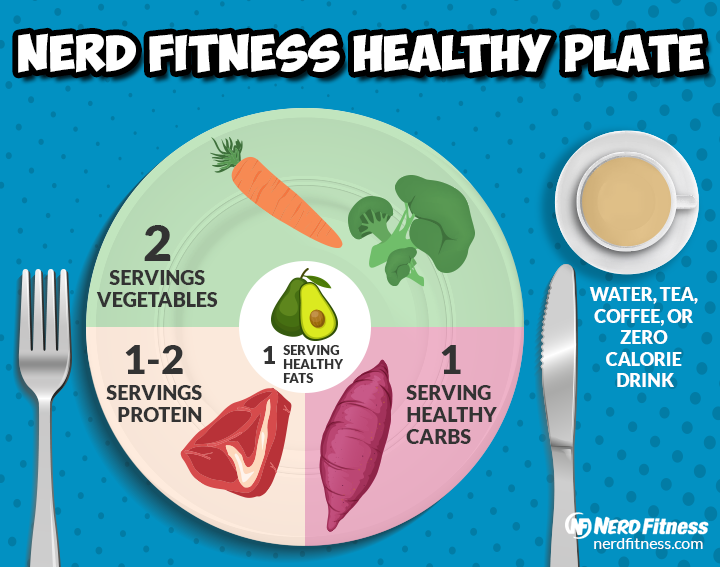
There are three big macronutrients that we’re going to focus on as we build our plate like the image above:
- Protein: building blocks for our muscles.
- Carbohydrates: our bodies will burn as fuel.
- Fats: can be burned as fuel, and also helps with nutrition absorption!
#1) PROTEIN: Priority Numero Uno.
Protein is amazing.
Your body uses protein to rebuild your muscles and keep you strong, especially if you are exercising or strength training regularly.
Protein is both good for you AND highly satiating.
Protein can come from any number of sources, including:
- Meat (beef, bison, pork).
- Poultry (chicken, turkey, duck).
- Eggs!
- Fish and shellfish (salmon, tuna, shrimp).
- Legumes (black beans, chickpeas).
A serving of protein is about the size and thickness of your palm.
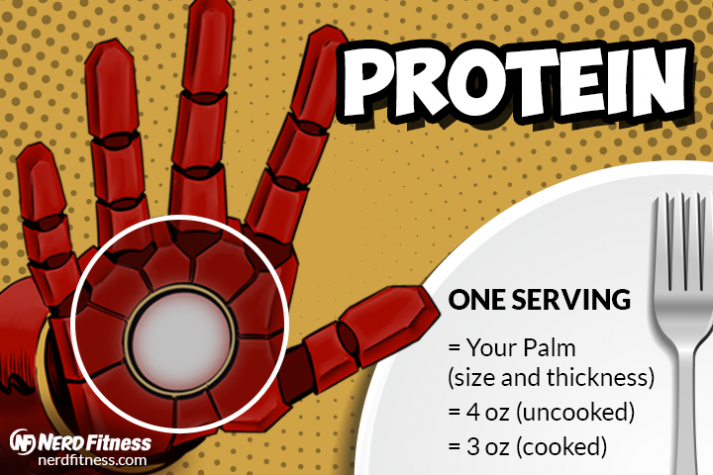
*The 4 oz serving is for an uncooked piece of meat. Cooking reduces about 25% of the weight, bringing it down to about 3 oz.
When building a plate, aim for the following amount of protein:
- Dudes: 1-2 servings (6-8 oz or about 170-228 g): two palms
- Dudettes: 1 serving (3-4 oz or about 85-114 g): 1 palm.
If you’re curious, here’s how much protein is in a serving of food:
- 4 oz (113 g) serving of chicken has around 30 g of protein.
- 4 oz (113 g) serving of salmon has 23 g of protein
- 4 oz (113 g) of steak has 28 g of protein.
How much protein should I eat per day? You can target anywhere from 80% to 100% of your bodyweight in pounds per gram of protein, with an upper limit of 250g:
- If you weigh 150 pounds (68 kg), target 120-150g of protein.
- If you weigh 200 pounds (90 kg), target 160-200g of protein.
- If you weigh 250 pounds (113 kg), target 200-250g of protein.
- If you weigh more than 250 pounds (113 kg), target 250g of protein.
#2: VEGETABLES: The difference-maker when it comes to healthy eating and weight management.
They are nutrient-dense: full of all the good nutrients that your body can use to function at optimal performance.
Next, they are voluminous but calorie-light, which means you can eat lots of them, you’ll feel full, but you’re unlikely to over-consume calories.
A serving of veggies is about the size of your fist.
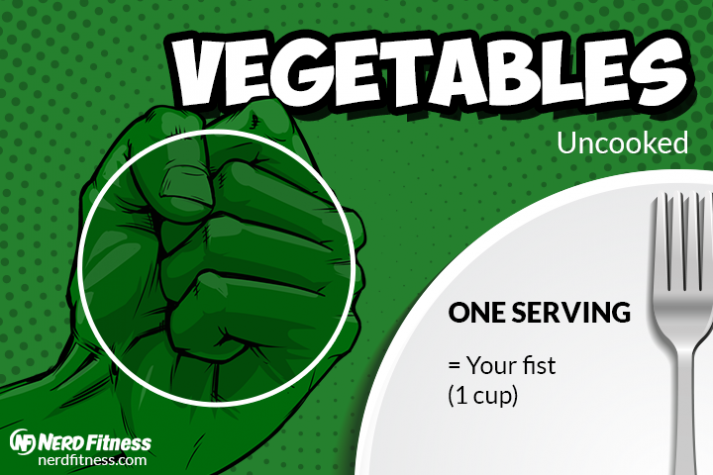
Remember this is what just 200 calories of broccoli looks like (holy crap). This is at least 5 full servings:
Here’s a quick, non-complete list of veggies that can fill your plate:
- Broccoli
- Broccolini
- Cauliflower
- Spinach
- Kale
- Spaghetti squash
- Brussels sprouts
- Zucchini
- Cucumber
- Carrots
- Onion
- Asparagus
Target 2 servings of vegetables on your plate – it should take up ½ the plate!
“But Steve, I don’t like vegetables…yet!”
That’s cool, I didn’t eat vegetables until I was 22. Now, they’re a main staple of every meal I eat.
To recap portion sizes of protein and vegetables:
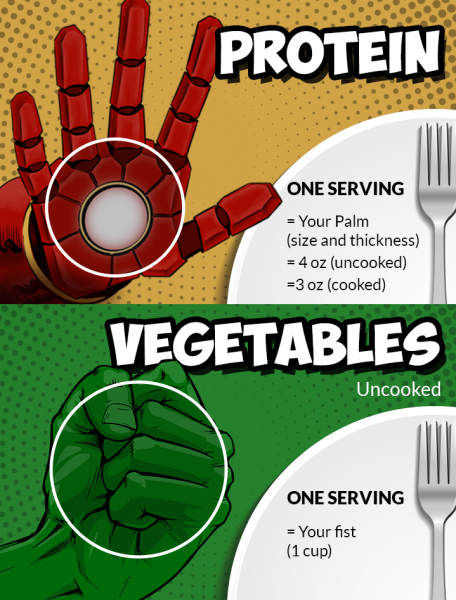
#3) HEALTHY CARBOHYDRATES: Fuel and fiber!
These are the foods that can be an important part of a diet, provided you eat them in the right quantities for your goals.
These foods are also great to consume right after a strenuous strength training workout to help your muscles and liver refill their glycogen stores (their energy tanks, essentially).
Examples of healthy carbohydrates:
- Rice
- Legumes, lentils
- Quinoa
- Potatoes
- Sweet potatoes
- Yams
- Whole grain bread (or pasta)
This is a list of REAL food, minimally processed, that also have plenty of fiber
Back to healthy carbs: when consumed in appropriate amounts, these are great foods that can help you feel full and give you energy and all that jazz.
Just make sure you know what an actual portion of these foods are!
To help you get better at eyeballing serving sizes:
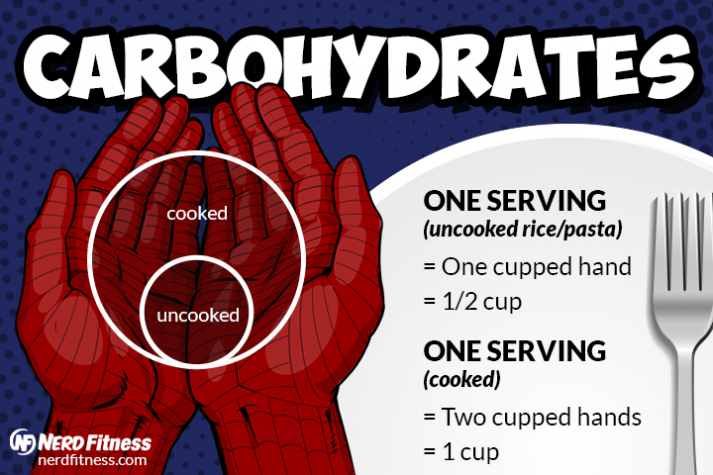
1 serving of a starchy carbohydrate is 1 cupped hand (uncooked), or your two hands forming a cup (cooked).
Fat is neither a superfood nor evil.
It’s just a macronutrient that you can eat that can help you reach your goals in the right quantity, or keep you from your goals if it’s overconsumed.
When your doctor tells you to eat more healthy fats, she’s referring to polyunsaturated and monounsaturated fats.
Healthy fat can be found in foods like:
- Avocado
- Almonds
- Walnuts
- Macadamia nuts
- Olive oil
- Almond butter
- Peanut butter
Now, science has recently come around on saturated fat too – once completely vilified, but now cautiously considered okay for moderate consumption.
Saturated fats can come from things like:
- Whole milk
- Full fat dairy
- Coconut oil
- Grass-fed butter
- Lard
- Fatty cuts of meat
Fat can be good for you provided you’re eating the right quantity for your goals.
However, like carbs, fats can be overconsumed accidentally too.
To help you gauge: a serving size of fat is roughly the size of your thumb!
